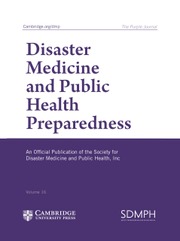We would like to propose an innovative approach using advanced image processing techniques to improve the monitoring and clinical management of patients in disaster areas, especially those trapped under debris. In mass casualty events such as earthquakes, continuous and reliable monitoring of vital signs is critical, but this is not always possible due to problems in reaching the patient, limited medical resources, and logistical difficulties. We believe that camera-based physiological monitoring systems can provide a practical and efficient solution in this area.
Discussion
In recent years, advances in computer vision and artificial intelligence have made it possible to extract basic physiological parameters such as heart rate, respiratory rate, oxygen saturation, and blood pressure from facial and skin images.Reference Molinaro, Schena and Silvestri 1 Integrating these technologies into disaster medicine can enable non-invasive, real-time patient monitoring in the field without the need for direct contact or traditional medical equipment.Reference Chen, Yi and Lim 3 In addition, the integration of machine learning algorithms can provide early detection of clinical deterioration, guiding the triage process and optimising resource allocation.Reference Tyler, Olis and Aust 4
A particularly promising application is the continuous prediction of blood urea nitrogen (BUN) levels using photoplethysmography and forward regression models.Reference Sridevi, Arefin and Das 2 As a key indicator of renal function, BUN can play a critical role in predicting renal function tests and providing early warning of patients with suspected crush syndrome trapped under debris.Reference Molinaro, Schena and Silvestri 1 By combining this parameter with other vital signs, teams on the ground can more comprehensively assess the overall condition of patients and improve decision making. In terms of tracking patients under rubble, such non-contact measurement systems offer a critical advantage. Particularly in the limited access conditions of debris fields, continuous monitoring of patients’ vital signs using remote sensing and vision-based solutions can increase the likelihood of a successful rescue operation. Furthermore, integrating these systems with thermal cameras can provide higher accuracy results by monitoring skin temperature changes and peripheral perfusion status.Reference Yang, He and Sadanand 5
We envisage that the system we have designed can work with standard camera equipment (even smartphone-based platforms) and securely transmit patient data in real time to central coordination units.Reference Abualenain 6 This concept, while innovative, requires interdisciplinary collaboration, rigorous validation studies, and integration with existing disaster response protocols.
Conclusion
We hope this idea will generate interest in the disaster medicine community. Thank you for considering this perspective and we look forward to the opportunity to contribute to the development of disaster medicine.
Author contribution
The author made significant contribution to the conception, study design, data collection, and analysis, as well as interpretation, or in all these areas; took part in drafting, revising, or critically reviewing the article; gave final approval of the version to be published; and agreed to be accountable for all aspects of the work.
Abdul Samet Sahin: Conceptualization, Investigation, Resources, Data curation, Writing- Original draft preparation, Writing - Review & Editing.


